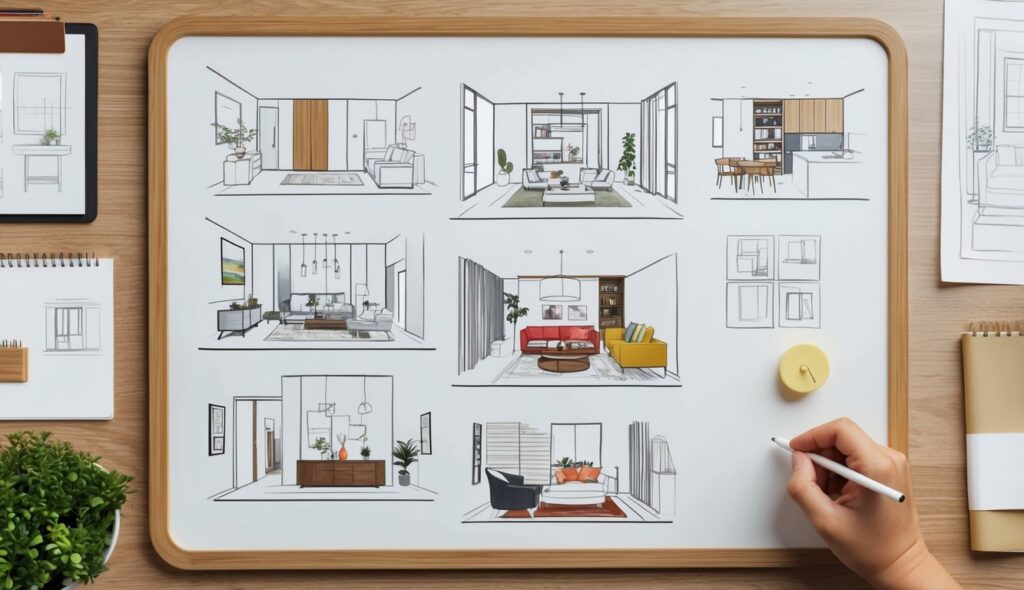Teak furniture plays an essential role in biophilic design.
Remember to repin your favorite images!
Integrating teak pieces into interiors not only brings an element of nature indoors but also significantly enhances the aesthetic and functional aspects of any space.
Teak’s natural resilience and warm tones make it an ideal material for creating a harmonious link between built environments and the natural world.
Teak’s durability and resistance to weathering allow it to age gracefully, maintaining its beauty and structural integrity over time.
This longevity aligns perfectly with sustainability goals in architectural design, reducing the need for frequent replacements and thereby minimizing environmental impact.
Its application in furniture ensures that spaces remain inviting and conducive to health and well-being.
When considering the practical applications, architects find that teak seamlessly integrates with both contemporary and traditional design elements.
The rich texture and natural variations in teak enhance the sensory experience of a room, fulfilling key principles of biophilic design.
By strategically placing teak furniture, designers can create spaces that not only look visually appealing but also promote a deeper connection with nature, fostering a healthier indoor environment.
Understanding Biophilic Design
Biophilic design integrates natural elements into the built environment to foster a connection with nature.
This design philosophy enhances well-being and improves quality of life by making mindful choices in architecture and interior design.
Principles of Biophilic Design
Biophilic design relies on principles that incorporate the natural world into architectural spaces.
Key principles include nature in the space, nature of the space, and natural analogues.
Nature in the space directly integrates natural elements such as plants, water, and natural light.
Nature of the space focuses on creating spatial harmony and forms that mimic natural habitats.
Natural analogues use materials and textures that evoke the essence of the natural environment, enhancing sensory experiences.
Materials and Elements in Biophilic Design
The use of natural materials is essential in biophilic design.
Wood, stone, and water are commonly used to replicate natural surroundings.
Textures play a vital role, providing tactile connections to nature.
Plants, natural light, and air quality improvements also contribute to this design.
Incorporating these elements can transform interior spaces, making them more aesthetically pleasing and environmentally friendly.
These choices not only enhance the visual appeal but also improve air quality and bring a sense of calm and rejuvenation.
Teak as a Biophilic Material
Teak wood is an excellent choice for biophilic design due to its natural beauty and durability.
Teak furniture adds warmth and an organic feel to spaces, which enhances the connection to nature.
Its rich textures and grains provide a tactile experience that aligns with biophilic principles.
Additionally, using sustainably sourced teak contributes to environmental benefits, making it a responsible choice for eco-conscious designs.
Teak aligns well with other natural elements like plants and stone, creating harmonious and cohesive interiors.
Health and Wellness in the Built Environment
Biophilic design significantly impacts health and wellness.
Exposure to natural elements like daylight and plants has been shown to improve mental health and reduce stress.
Enhanced air quality through the inclusion of plants and natural forms contributes to better physical health.
Incorporating natural materials and designs promotes overall well-being, supporting a healthier lifestyle.
This design philosophy not only benefits individual inhabitants but also contributes to the broader aim of creating sustainable and livable environments.
Teak in Biophilic Interior Design
Teak plays a vital role in biophilic interior design by combining natural beauty and durability, making it a popular choice for furniture in modern spaces.
This section covers the characteristics, environmental impact, and ways to incorporate teak in contemporary interiors.
Characteristics of Teak Furniture
Teak is known for its strength and durability. It has a natural resistance to decay, pests, and weather, making it suitable for both indoor and outdoor use.
The rich, warm tones of teak wood add a sense of elegance and comfort to any space.
Its high oil content gives it a natural luster without the need for additional finishes, enhancing indoor air quality by reducing the need for chemical treatments.
Teak furniture often features organic forms and smooth surfaces, which align well with biophilic design principles.
These organic characteristics create a natural aesthetic that fosters a calming and productive environment.
Designers frequently utilize teak in furniture to blend seamlessly with both traditional and modern architectural styles, making it a versatile material in biophilic interiors.
Environmental Impact and Sustainability of Teak
The sustainability of teak is a critical consideration in its use for biophilic interior design.
Teak is often harvested from sustainable plantations that follow strict forestry management practices.
This ensures that the extraction of teak does not deplete natural resources or harm ecosystems.
Sustainable teak production supports responsible forestry, maintaining the balance between economic needs and environmental conservation.
Teak’s long lifespan contributes to its sustainability, as it reduces the need for frequent replacement and minimizes waste.
Using teak in furniture design also encourages a connection to nature, promoting environmental mindfulness.
By choosing teak from reputable sources, designers can create interiors that are both beautiful and environmentally responsible. For high-quality options, Westminster Teak is a leading provider of sustainable teak furniture.
Incorporating Teak in Modern Spaces
Teak furniture can be seamlessly integrated into modern workspaces and homes, enhancing both aesthetic appeal and functional design.
Its natural beauty and durability make it an ideal choice for desks, chairs, and conference tables. The warm tones of teak create a welcoming atmosphere, promoting comfort and productivity in professional settings.
In residential interiors, teak can be used in living rooms, bedrooms, and dining areas to create a cohesive look that brings the outdoors in.
Pairing teak with natural elements like stone, plants, and water features enhances the biophilic experience.
Contemporary design trends often favor minimalist teak furniture pieces that highlight the wood’s natural grain and texture, aligning with modern, clean-lined aesthetics.
Using teak in biophilic design not only adds elegance to spaces but also supports sustainable materials and practices, making it a preferred choice among architects and interior designers focused on creating harmonious, nature-inspired environments.

